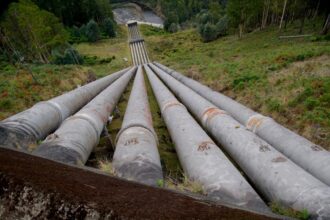The race for nuclear supremacy during the mid-20th century was a defining aspect of the Cold War, with the Soviet Union emerging as a formidable contender in this high-stakes competition. Following the detonation of the first atomic bomb by the United States in 1945, the Soviet leadership recognized the urgent need to develop their own nuclear capabilities. This realization was not merely a matter of national pride; it was a strategic imperative that would shape the geopolitical landscape for decades to come.
The Soviet Union’s pursuit of nuclear weapons was driven by a desire to ensure national security, counterbalance American military power, and assert its influence on the global stage. As the United States began to consolidate its position as a nuclear superpower, the Soviet Union embarked on an ambitious program to develop atomic weapons. This endeavor was marked by a sense of urgency and secrecy, as Soviet leaders understood that possessing nuclear capabilities would provide them with a significant advantage in international relations.
The race for the bomb was not just about technology; it was also about ideology, as the Soviet Union sought to demonstrate the superiority of its socialist system in contrast to Western capitalism. The stakes were high, and the implications of this race would reverberate throughout the Cold War era.
Key Takeaways
- The Soviet Union’s race for the bomb was driven by the desire to match the nuclear capabilities of the United States.
- Soviet nuclear research in the early years focused on developing the technology and expertise needed to build an atomic bomb.
- Soviet scientists and spies played a crucial role in obtaining nuclear secrets from the United States and other countries.
- The Soviet Union’s secret nuclear facilities were strategically located and heavily guarded to prevent espionage and sabotage.
- Soviet industry played a significant role in the atomic bomb project by providing the necessary resources and infrastructure for research and development.
The Early Years of Soviet Nuclear Research
In the aftermath of World War II, Soviet scientists began laying the groundwork for their nuclear program. The early years of Soviet nuclear research were characterized by a combination of theoretical exploration and practical experimentation. Key figures such as Igor Tamm and Andrei Sakharov emerged as pivotal contributors to the scientific community, pushing the boundaries of knowledge in nuclear physics.
Their work was often conducted under strict government oversight, reflecting the intense focus on achieving results that could bolster national security. The Soviet Union’s approach to nuclear research was heavily influenced by its wartime experiences and the need for rapid advancements. The government allocated substantial resources to scientific institutions, fostering an environment where innovation could thrive.
However, this period was also marked by challenges, including limited access to information and technology due to the West’s monopoly on nuclear knowledge. Despite these obstacles, Soviet scientists demonstrated remarkable ingenuity, often relying on their own theoretical frameworks and experimental designs to make significant strides in nuclear research.
The Influence of Soviet Scientists and Spies

The success of the Soviet atomic bomb program can be attributed not only to the efforts of dedicated scientists but also to a network of spies who infiltrated Western nuclear projects. The contributions of individuals like Klaus Fuchs and Theodore Hall were instrumental in providing the Soviets with critical information about atomic research and development. These spies operated under a cloak of secrecy, motivated by ideological beliefs and a desire to level the playing field between East and West.
Soviet scientists were acutely aware of the importance of intelligence gathering in their quest for nuclear capabilities. They worked closely with intelligence agencies to analyze and utilize information obtained from espionage activities. This collaboration allowed them to accelerate their research and development efforts, ultimately leading to breakthroughs that would have taken much longer without such insights.
The interplay between scientific innovation and espionage created a unique dynamic that propelled the Soviet Union forward in its race for the bomb.
The Soviet Union’s Secret Nuclear Facilities
| Facility Name | Location | Year of Establishment | Number of Reactors |
|---|---|---|---|
| Chelyabinsk-65 | Chelyabinsk, Russia | 1948 | 3 |
| Mayak Production Association | Ozyorsk, Russia | 1948 | 4 |
| Siberian Chemical Combine | Seversk, Russia | 1949 | 5 |
| Arzamas-16 | Sarov, Russia | 1946 | 2 |
To support its ambitious nuclear program, the Soviet Union established a network of secret facilities dedicated to research, development, and production. These sites were often located in remote areas, shielded from prying eyes and potential espionage threats. One of the most notable facilities was the closed city of Arzamas-16, which became a hub for nuclear research and engineering.
Here, scientists worked tirelessly to design and test various components essential for atomic weaponry. The secrecy surrounding these facilities was paramount, as any leak of information could jeopardize national security. The Soviet government implemented strict security measures, including restricted access and surveillance, to protect their nuclear secrets.
This environment fostered a culture of innovation but also created challenges for scientists who often operated under immense pressure to deliver results quickly. Despite these challenges, the establishment of these secret facilities played a crucial role in advancing the Soviet Union’s nuclear capabilities.
The Role of Soviet Industry in the Atomic Bomb Project
The successful development of an atomic bomb required not only scientific expertise but also robust industrial support. The Soviet Union’s industrial base was mobilized to produce the necessary materials and components for nuclear weapons. Factories were repurposed or built from scratch to manufacture uranium enrichment equipment, explosives, and other critical elements needed for bomb construction.
Soviet industry faced significant challenges during this period, including resource shortages and technological limitations. However, through centralized planning and state control, the government was able to prioritize nuclear production and allocate resources effectively.
The collaboration between scientists and industrial workers was essential in overcoming these obstacles, as both groups worked towards a common goal: developing a viable atomic bomb that could secure the nation’s future.
The Soviet Union’s First Successful Nuclear Test

On August 29, 1949, the Soviet Union achieved a monumental milestone with its first successful nuclear test, codenamed “First Lightning.” This event marked a turning point in global politics and signaled that the balance of power had shifted dramatically. The test took place at the Semipalatinsk Test Site in Kazakhstan, where scientists had meticulously prepared for this momentous occasion. The successful detonation of an atomic bomb not only validated years of research and development but also instilled a sense of pride among Soviet leaders and citizens alike.
The implications of this test were profound.
The successful demonstration of nuclear capability allowed the Soviet Union to assert itself as a global player on par with the United States.
This event intensified the arms race and heightened tensions during the Cold War, as both nations sought to expand their arsenals and develop more advanced weaponry.
The Impact of the Soviet Atomic Bomb on the Cold War
The introduction of the Soviet atomic bomb fundamentally altered the dynamics of the Cold War. With both superpowers now possessing nuclear capabilities, a precarious balance of power emerged that shaped international relations for decades. The doctrine of mutually assured destruction (MAD) became a central tenet of military strategy, as both sides recognized that any conflict could escalate into catastrophic nuclear war.
This realization led to a tense standoff characterized by an arms race that saw both nations stockpiling vast arsenals. The presence of nuclear weapons also influenced diplomatic negotiations and alliances during this period. Countries aligned with either superpower were often compelled to consider their own security in light of nuclear capabilities.
The fear of nuclear confrontation loomed large over global politics, leading to various treaties aimed at controlling proliferation and reducing tensions. However, despite these efforts, the specter of nuclear war remained ever-present, underscoring the profound impact that the Soviet atomic bomb had on shaping Cold War dynamics.
The Legacy of the Soviet Union’s Atomic Bomb Program
The legacy of the Soviet Union’s atomic bomb program is multifaceted, encompassing scientific achievements, geopolitical shifts, and ethical considerations surrounding nuclear weapons. On one hand, the program showcased remarkable advancements in physics and engineering, contributing significantly to global scientific knowledge. Many Soviet scientists became renowned figures in their fields, leaving behind a rich legacy that continues to influence contemporary research.
On a broader scale, however, the legacy is also marked by the ethical dilemmas posed by nuclear weapons. The development and proliferation of atomic bombs raised profound questions about humanity’s capacity for destruction and responsibility towards future generations. The Cold War era was characterized by an ongoing struggle between deterrence and disarmament, with debates surrounding nuclear ethics continuing to resonate today.
Ultimately, the legacy of the Soviet atomic bomb program serves as a reminder of both human ingenuity and vulnerability in an increasingly complex world.
The Soviet Union’s Espionage Efforts to Obtain Nuclear Secrets
Espionage played a critical role in accelerating the Soviet Union’s atomic bomb program, as intelligence-gathering efforts provided invaluable insights into Western nuclear developments. The recruitment of spies within key scientific institutions allowed Soviet officials to obtain classified information that would have otherwise taken years to acquire through legitimate means. This network of espionage not only bolstered scientific understanding but also instilled a sense of urgency within Soviet leadership regarding their own nuclear ambitions.
The success of these espionage efforts can be attributed to various factors, including ideological motivations among spies who believed in communism’s superiority over capitalism. Many operatives were willing to risk their lives for what they perceived as a noble cause—leveling the playing field between East and West. This commitment resulted in significant intelligence breakthroughs that ultimately contributed to the successful development of atomic weapons in the Soviet Union.
The International Response to the Soviet Union’s Atomic Bomb
The successful detonation of an atomic bomb by the Soviet Union elicited varied responses from around the world. For many Western nations, particularly those aligned with the United States, this event was met with alarm and concern over an escalating arms race. Governments recognized that they needed to reassess their own security strategies in light of this new reality; thus began an era marked by heightened military preparedness and increased defense spending.
In contrast, some nations viewed the emergence of a second nuclear power as an opportunity for greater multipolarity in international relations. Countries that had previously aligned themselves solely with Western powers began exploring alternative alliances or pursuing their own nuclear ambitions. This shift underscored how deeply interconnected global politics had become in response to developments within superpower rivalries.
The Soviet Union’s Nuclear Arsenal and its Impact on Global Politics
The establishment of a formidable nuclear arsenal by the Soviet Union had far-reaching implications for global politics throughout much of the 20th century. As both superpowers amassed vast stockpiles of weapons capable of causing unprecedented destruction, international relations became increasingly defined by deterrence strategies aimed at preventing conflict through fear of mutual annihilation. This precarious balance shaped diplomatic negotiations and military posturing during critical moments such as crises in Cuba or Berlin.
Moreover, as other nations sought to develop their own nuclear capabilities—often inspired by or reacting against superpower dynamics—the landscape became even more complex. Non-proliferation treaties emerged as attempts to curb this trend; however, tensions persisted as countries navigated competing interests within an evolving geopolitical framework influenced heavily by existing arsenals held by both superpowers. In conclusion, while many aspects surrounding these developments remain contentious today—ranging from ethical considerations regarding warfare technologies to ongoing debates about disarmament—the legacy left behind by these historical events continues shaping contemporary discussions around security policy worldwide.
The story of how the Soviets acquired the atomic bomb is a fascinating tale of espionage, scientific ambition, and geopolitical strategy. During the early years of the Cold War, the Soviet Union was determined to break the United States’ monopoly on nuclear weapons. This ambition led to a complex web of intelligence operations and scientific endeavors. For a deeper understanding of the intricate dynamics and historical context surrounding this pivotal moment in history, you can explore a related article on the topic by visiting In The War Room. This resource provides valuable insights into the strategies and challenges faced by the Soviets in their quest to develop their own atomic capabilities.
WATCH THIS 🤯How the KGB Stole America’s Future
FAQs
What is the article “How the Soviets got the atomic bomb” about?
The article discusses the Soviet Union’s efforts to develop and acquire the atomic bomb during the mid-20th century, including the scientific, political, and espionage-related aspects of their successful endeavor.
When did the Soviet Union first develop the atomic bomb?
The Soviet Union successfully tested their first atomic bomb on August 29, 1949, marking their entry into the nuclear arms race.
What were the key factors that contributed to the Soviet Union’s development of the atomic bomb?
Key factors included the recruitment of prominent scientists, espionage efforts to acquire information from the United States, and a focused national effort to develop nuclear technology.
How did the Soviet Union’s development of the atomic bomb impact global politics?
The Soviet Union’s acquisition of the atomic bomb significantly altered the global balance of power, leading to increased tensions and the beginning of the Cold War between the United States and the Soviet Union.
What role did espionage play in the Soviet Union’s acquisition of the atomic bomb?
Espionage played a significant role, as Soviet agents successfully obtained information about the atomic bomb from the United States, including details about the Manhattan Project and its scientific developments.
What were the long-term implications of the Soviet Union’s acquisition of the atomic bomb?
The Soviet Union’s possession of the atomic bomb led to an arms race with the United States, increased global tensions, and the proliferation of nuclear weapons technology to other countries.




